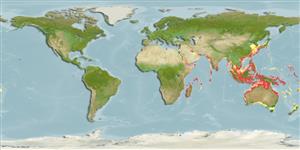Common names from other countries
>
Syngnathiformes (Pipefishes and seahorses) >
Centriscidae (Snipefishes and shrimpfishes) > Centriscinae
Etymology: Centriscus: Derived from Greek, kentris, -idos = sting (Ref. 45335).
More on author: Linnaeus.
Environment: milieu / climate zone / depth range / distribution range
Ecologie
marien; brak water rifbewoner; diepte 2 - 100 m (Ref. 37816), usually 2 - 15 m (Ref. 90102). Tropical; 34°N - 35°S, 32°E - 172°E
Indo-Pacific: Red Sea and Arabian Gulf (Ref. 11441) to New Guinea, north to southern Japan, south to New South Wales, Australia.
Grootte / Gewicht / Leeftijd
Maturity: Lm ? range ? - ? cm
Max length : 17.0 cm TL mannelijk / geslacht onbekend; (Ref. 110387)
Dorsale stekels (totaal) : 3; Dorsale zachte stralen (totaal) : 10 - 12; Anale zachte stralen: 11 - 12. Silvery with reddish brown to blackish mid-lateral stripe. Main dorsal spine moderately long and without joint (Ref. 48635).
Inhabits sandy or muddy floors of shallow inlet waters. Usually in large schools among branching corals, seawhip gardens and black coral bushes to about 15 m depth. Small juveniles in surface waters and sometimes in small groups along beach edges in quiet bays and settle with crinoids or urchins (Ref. 48635). Usually processed into fishmeal (Ref. 2858).
Levenscyclus en paargedrag
Maturities | Voortplanting | Spawnings | Egg(s) | Fecundities | Larven
Masuda, H., K. Amaoka, C. Araga, T. Uyeno and T. Yoshino, 1984. The fishes of the Japanese Archipelago. Vol. 1. Tokai University Press, Tokyo, Japan. 437 p. (text). (Ref. 559)
Status op de Rode Lijst van het IUCN (Ref. 130435)
CITES (Ref. 128078)
Not Evaluated
Gevaar voor de mens
Harmless
Gebruik door de mens
Visserij: commercieel; Aquarium: Commercieel
Tools
Speciale rapporten
Download XML
Internetbronnen
Estimates based on models
Preferred temperature (Ref.
115969): 24.8 - 29.3, mean 28.4 (based on 3743 cells).
Fylogenetische diversiteitsindex (Ref.
82804): PD
50 = 0.7502 [Uniqueness, from 0.5 = low to 2.0 = high].
Bayesian length-weight: a=0.00282 (0.00106 - 0.00750), b=3.10 (2.86 - 3.34), in cm Total Length, based on LWR estimates for this (Sub)family-body shape (Ref.
93245).
Trofisch niveau (Ref.
69278): 3.3 ±0.4 se; based on size and trophs of closest relatives
Weerstandsvermogen (Ref.
120179): Hoog, minimale populatieverdubbelingstijd minder dan 15 maanden (Preliminary K or Fecundity.).
Fishing Vulnerability (Ref.
59153): Low vulnerability (10 of 100).
